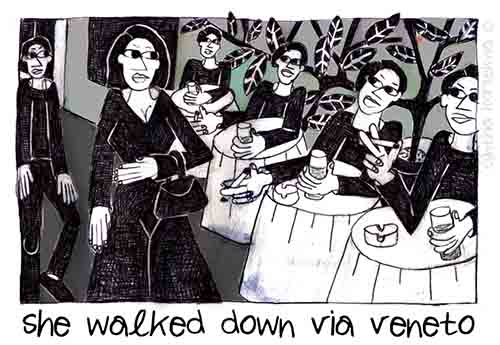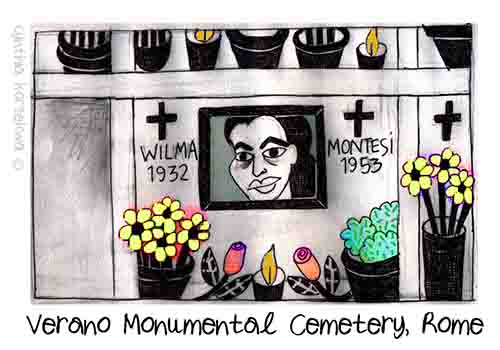It was the day before Easter of 1953 when fishermen found a young woman’s body on the beach of Torvaianica not far from Rome. Her face was in the sand and her shoes, stockings, garter belt, and skirt were missing. A day later the woman was identified as 21 year old Wilma Montesi.

Wilma’s story is not only that of a young woman’s tragic death but of the expectations a woman living in Rome in 1953 could have had for herself.
When Wilma was born, Benito Mussolini was in his 10th year as dictator. The Fascist regime, like the Catholic Church, saw women as inferior beings who were not entitled to the same rights as men. Although Mussolini wanted to modernize Italian society, he wanted to keep women at home in the role of mothers and wives. World War II changed all that and, in 1946, Italian women voted for the first time. But political liberation is one thing and economic liberation another.

Mussolini, like Hitler, practiced personality cultism to maintain his power. And this meant using mass media as a form of propaganda. Propaganda addresses the masses focusing on those of low intellect and aims to awaken a certain kind of imagination, a dream for something that doesn’t exist. And Mussolini sought to awaken that imagination. He kept a copy of Gustave Le Bon’s The Crowd: A Study of the Popular Mind on his nightstand. Le Bon claimed “that an individual immersed for some length of time in a crowd soon finds himself – either in consequence of magnetic influence given out by the crowd or from some other cause of which we are ignorant – in a special state, which much resembles the state of fascination in which the hypnotized individual finds himself in the hands of the hypnotizer.”

“The great majority of a nation is so feminine in its character and outlook that its thought and conduct are ruled by sentiment rather than by sober reasoning. This sentiment, however, is not complex, but simple and consistent. It is not highly differentiated, but has only the negative and positive notions of love and hatred, right and wrong, truth and falsehood.” from Hitler’s Mein Kampf
Despite Mussolini’s WW II defeat, the media still continued to use his techniques. However, new personalities were needed to idolized and so the focus was now on movie stars and the elite. News kiosks were covered with photo mags with beautiful young starlets on their covers. Now imagine Wilma who, like most women of the time, was not permitted to aspire for anything other than marriage which meant staying at home cooking, cleaning and caring for others. But seeing these magazines made her think Why can’t I become a star, too?” So Wilma, like so many young women of the time, had dreams of becoming part of il mondo dello spettacolo—the world of entertainment.

So we have Wilma, living at home with her family, engaged to someone who not only lived in another town but someone she doesn’t even like. Dissatisfied with her prospectives, she looked for a change. But it was this change that led to her death.
On the afternoon of April 9, 1953, Wilma left her home on via Tagliamento 74 (Rome) and never came back. When she didn’t show up for dinner, her parents got worried. They went to the police and discovered a day later that her body had been found. Immediately, the police said that it was a suicide but her family, worried about their reputation and knowing a suicide meant Wilma couldn’t be buried on church grounds, insisted that further inquiries be made. So the police then said that her death was accidental—that she’d gone to Ostia to wade in the water but fainted and drowned. Obviously there was much curiosity and speculation about this case but it eventually died down.
Then several months later, Silvano Muto’s gossip magazine, L’Attualità, came out with a story entitled La verità sul caso Montesi (The Truth About the Montesi Case). Investigation led him to a young actress name Adriana Concetta Bisaccia who frequented Rome’s “bel mondo” who said she had, along with Wilma, participated in an orgy at marchese Ugo Montanga’s Capocotta estate located in the area Wilma’s body had been found. Wild parties were often held there attended mainly by young women hoping to become actresses and men who were rich and powerful experts in making unfulfilled promises.

Adriana, nicknamed The Existentialist, is a troubled soul. At a very young age, she got pregnant and went to Rome in search of a solution. Here a blotched abortion lead to an inflammatory disease causing her so much pain that she often thought of killing herself. To distract herself from the pain, she began hanging out at Il Baretto on via del Babuino where she met many drug users. She also met people like Piero Piccioni (son of Attilio Piccioni, politician and important member of the dominating Christian Democrat party) who introduced her to the Capocotta group.
At one of these feasts of dissolute notables, Wilma took an excess of drugs and passed out. Wanting to avoid a scandal, Wilma’s body was taken away and dumped on the Torvaianica beach. The story was further confirmed by another would-be actress, Anna Maria Moneta Caglio know as The Black Swan because of her dark hair and long neck. Anna Maria came from a prominent Milanese family and was the ex-girlfriend of Ugo Montagna. She later testified that Wilma had died while she was with Piero Piccioni. After Wilma’s death and the related trial, Anna Maria got a role in the film Ragazza di Via Veneto.

And now Italian politics officially entered into the investigation of Wilma Montesi’s death. Italy was going through a major transition—from a dictatorship to a democratic republic. During this time there was much political confusion. The first elections as a republic had taken place only seven years before. The Americans and Catholic Church had imposed themselves politically resulting in the victory of the Christian Democratic Party full of recycled Fascists. Their main competition had come from the Communists Party full of members of the Italian resistance movement. So there was the idea that the civil war that existed during the war was in some way continuing. And the Montesi case provided the anti-Christian Democrats with much ammunition (somewhat like the Clinton-Lewinsky case).

The corrupted elite, show biz hungry women, orgies—it was all very exciting. Scandal sells and the tabloids enjoyed an economic boom. Paparazzi multiplied like rabbits and stalked anyone capable of providing them with saleable photographs.

Cameras were flashing everywhere. So to hide themselves or to protect their eyes, celebrities began wearing sunglasses.

Via Veneto is pretty yawn provoking today. But once it was where the elite hung out to let everyone know they were elite and for starlets looking for a means of meeting people in the movie industry or a potential husband. The main activity was that of men sitting and drinking (thus giving birth to the cocktail generation) as they watched women sashay down the street.

Fellini’s Dolce Vita was, in many ways, inspired by the Montesi Case. The term “paparazzo” was based on Coriolano Paparazzo, a character in George Gissing’s southern Italy travel narrative entitled By The Ionia Sea. However, the person who inspired the paparazzo prototype was Tazio Secchiaroli, a professional photographer who’d told Fellini about his fights with various celebrities and running around on his scooter looking for a scoop.
Four years after the discovery of Wilma’s body on the beach, Piccioni and Montagna are cleared of having anything to do with her death (Piccioni even become an award winning music composer for movies). Muti and Anna Maria, instead, are convicted of slander. And, as for the poor Wilma, her case still remains unresolved.

Wilma Montesi (1932 – 1953) is buried at the Verano Monumental Cemetery (Collocazione: Scaglione Tiburtina).

with the new tombstone

Verano Monumental Cemetery series
.
.
Bibliography: Gundle, Stephen. Death and the Dolce Vita: The Dark Side of Rome in the 1950s. Canongate Books. Edinburgh. 2011.
Related: In Italia Garcia Marquez fu cronista per il caso Montesi + The scandal that inspired La Dolce Vita + even Georges Simenon interested in Montesi case






Pingback: Vieni, Marcello, viene! | the photogenic lifestyle of cynthia korzekwa
Pingback: Wilma Montesi – Verano Monumental Cemetery in Rome
Pingback: 5 November | the photogenic lifestyle of cynthia korzekwa